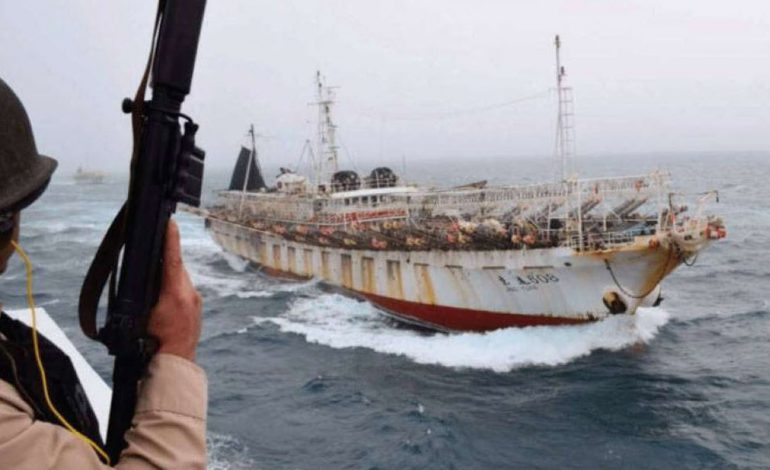
China to Latin America: All your fish belong to us
By: Ben Kritz
19 September 2022
As if communist China was not already doing enough to degrade the rest of the world’s quality of life for its own gain, recent news from South and Central America further reinforces the impression that its rapaciousness knows no bounds. China’s Southeast Asian neighbors, particularly the Philippines, are already familiar with the Red Menace’s greediness when it comes to marine resources, but on the other side of the world, a massive, well-organized, industrial-scale effort to carry out illegal fishing on both sides of Latin America is threatening to wipe out fish stocks for a dozen countries.
In a news report by Inter-Press Service (IPS) last month, 631 Chinese-flagged fishing vessels were reported to have entered Peruvian and Ecuadorian waters so far this year. Over the past two years, Chinese fishing in the territorial waters or the exclusive economic zones (EEZ) of the South American countries bordering the Eastern Pacific has skyrocketed. This year’s number of vessels already exceeds the 584 logged in all of 2021, which was in turn a sharp increase from the 350 ships in 2020.
The typical season for the Chinese fleet begins in April or May, when they arrive in the Eastern Pacific off Central America and northern South America. The fleet then gradually works its way southward, eventually passing through the Strait of Magellan into the South Atlantic to fish the waters off Argentina, Uruguay and Brazil.
Most alarmingly, Ecuadorian authorities have accused the Chinese of fishing with impunity in the Galapagos Islands, the world’s most biodiverse region, and which is surrounded by a 193,000-square kilometer marine protected area. Under Ecuadorian regulations, only “artisanal” fishing by a limited number of local fishermen is permitted in the Galapagos as part of the country’s resource management program for the marine protected area.
Farther south, fishermen in Peru have sounded the alarm about Chinese overfishing of giant squid, which is the country’s second-biggest marine resource after anchovies. Squid fishing ordinarily provides about $800 million in revenue and thousands of jobs for Peruvians, but the industry is on the verge of being wiped out by the unwelcome competition from the Chinese. Moreover, the Chinese presence has completely derailed Peru’s carefully managed program to impose harvest limits to ensure sustainability of the squid population.
Other fish being harvested by the Chinese in massive quantities include several species of tuna, hake, prawns, shortfin squid and sharks. Shark fishing is uniformly banned throughout Central and South America, but huge demand for it in China — particularly in Hong Kong, apparently — induces the Chinese ships to ignore the bans, hiding the illegal catch by transferring it between ships to evade the different countries’ naval or coast guard patrols.
For some Latin American fishermen, the money to be made from sharks and other illegal species along with the loss of their regular harvest to the Chinese has enticed them to engage in illegal fishing as well, aggravating the problem. Authorities in Mexico, Chile and Brazil have reported intercepting and arresting dozens of fishermen from their own countries for illegal fishing.
The United Nations Food and Agriculture Organization (FAO) has also sounded the alarm, but noted that unchecked Chinese fishing is not limited to Latin American waters. In a statement, FAO regional fisheries officer Alicia Mosteiro Cabanelas said that “illegal, unreported and unregulated fishing is a global problem that compromises the conservation and sustainable use of fishery resources. Overfishing always has a direct impact on the sustainability of resources, generating a decrease in income for the fishing sector and in the availability of fishery products for local communities and consumers in general. Latin America is no exception. It also harms fishers’ livelihoods and related activities, and aggravates malnutrition, poverty and food insecurity.”
China has the world’s largest fishing fleet, estimated at 17,000 vessels harvesting about 15 million tons of marine products per year. Not all of that is illegally caught, of course, but the amount that is — either protected or regulated species, or harvested in other countries’ territorial waters — is estimated to be at least 20 percent, or about 3 million tons per year.
For its part, China avows that it does not approve of illegal fishing, and has on paper, at least, formally banned its fleet from operating in prohibited waters and warned ship captains that it will withdraw licenses from those who violate the rules. Chinese President Xi Jinping reportedly gave assurances to that effect to his Ecuadorian counterpart Guillermo Lasso when the latter visited Beijing in February of this year. So far, however, that seems to have been typical Chinese government lip service; the fleet continues to operate with impunity across the globe, and no cases of any Chinese ship owner or captain being penalized by his own government are known.
Not surprisingly, the Chinese effort to depopulate the world’s oceans has become another front in the new cold war of China versus almost everyone else. At a summit of the Quadrilateral Security Dialogue (QSD) bloc in Tokyo in May, Australian Prime Minister Anthony Albanese, US President Joe Biden, Prime Minister Narendra Modi of India and Japanese Prime Minister Fumio Kishida agreed on “new surveillance mechanisms” for the Chinese fishing fleet. In addition, the US government has decided to dust off the Monroe Doctrine, and is currently working on security agreements with countries such as Colombia, Costa Rica, Ecuador, Mexico and Panama to improve monitoring and law enforcement efforts against the Chinese fleet.


